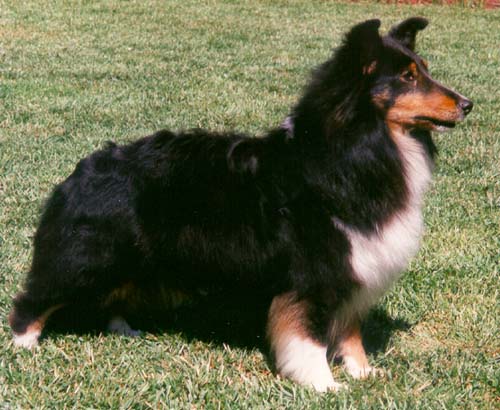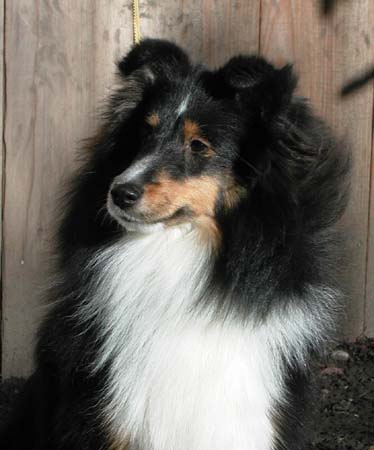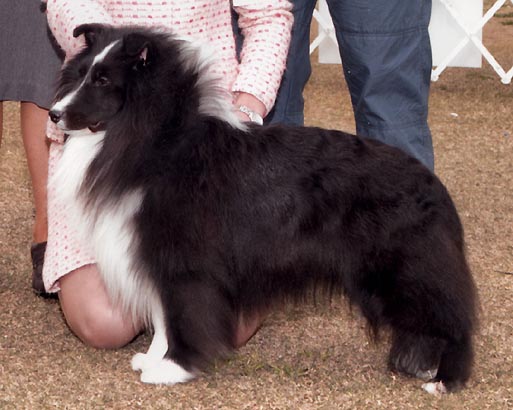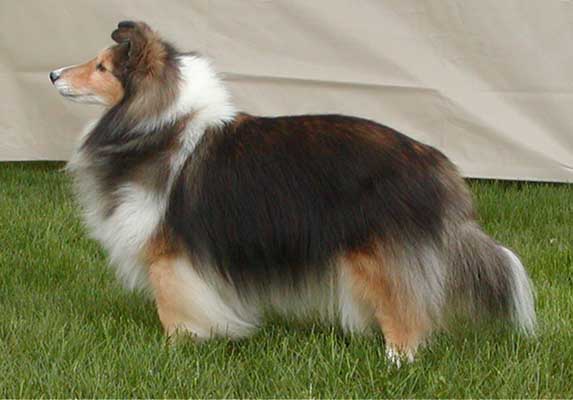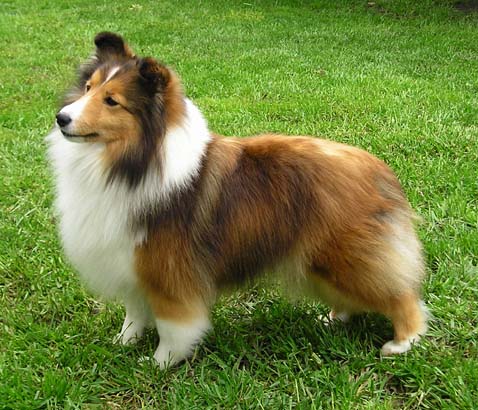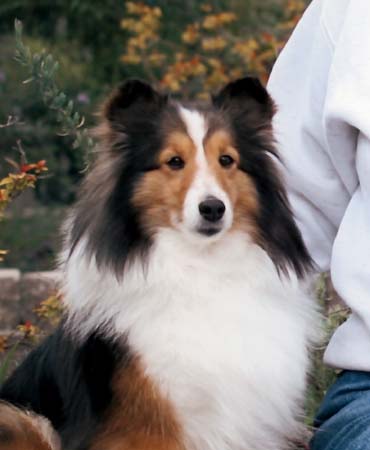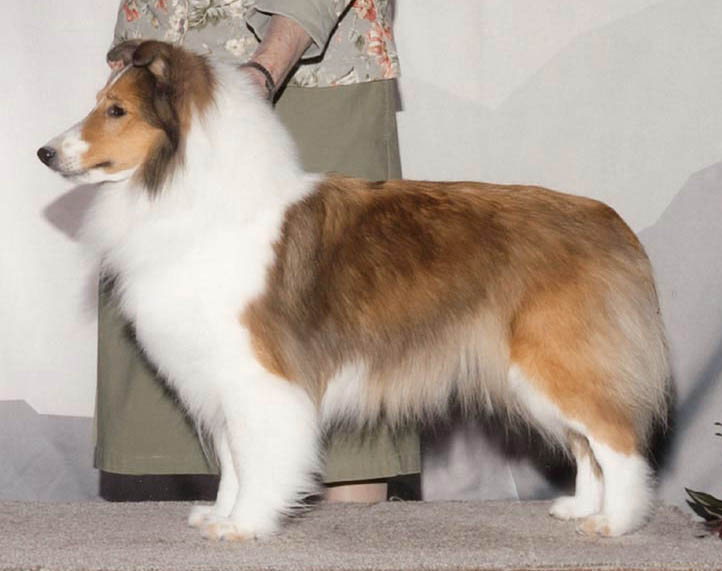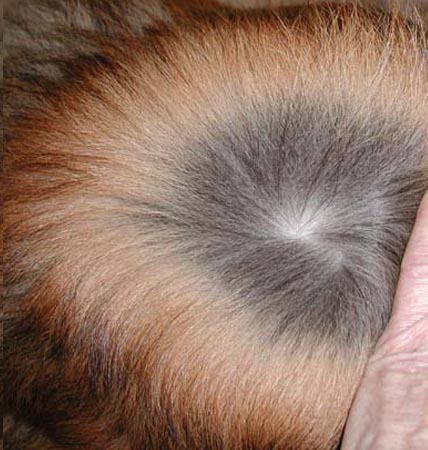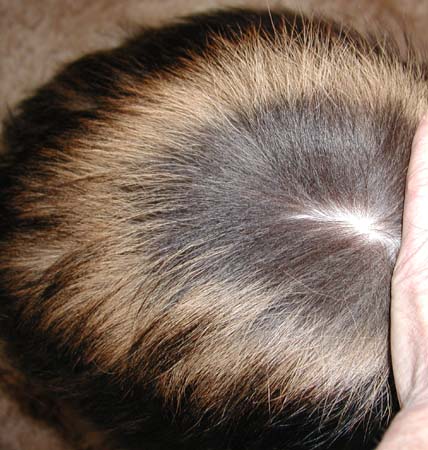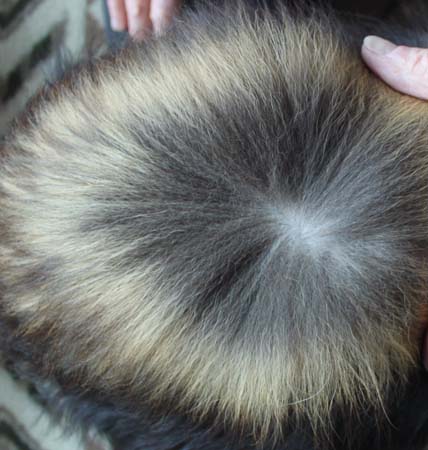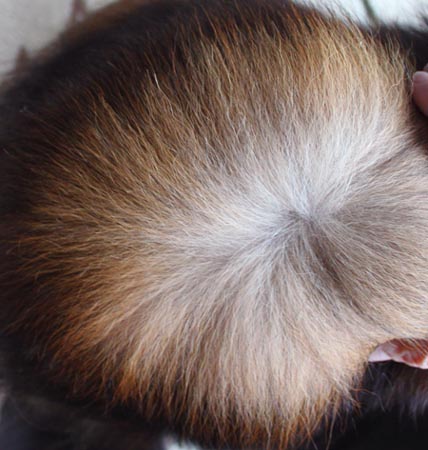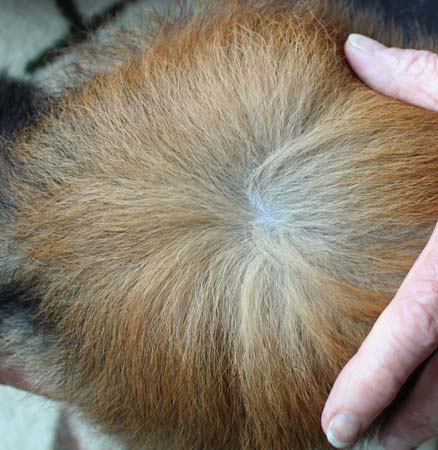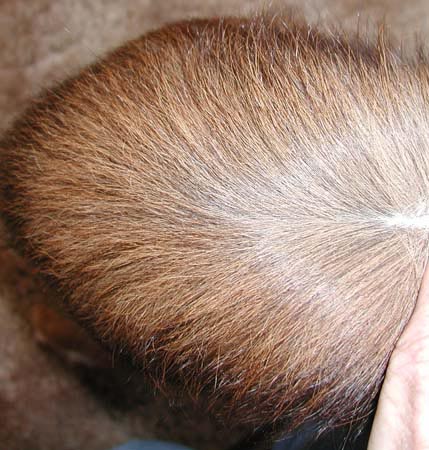|
|
 Reg
Where performance counts!
|
|
|
What Is A Tricolor?
A tricolor Sheltie has a specific pattern of
tan points in a predominantly black coat. The
identical pattern of tan points is found in many breeds,
whether or not white is superimposed on the color.
But not all Shelties who have black, tan and
white hair are tricolors! A sable, although usually
predominantly tan, often has black and black-tipped
hair in a predominantly tan and white coat. A sable dog is
not a tricolor, even if there are so many black-tipped hairs
that the body color appears at first glance to be black.
A Sheltie is correctly called tricolor only
when
(1) the predominant color is black,
(2) it has the typical black and tan pattern of points (except where they
are hidden by white), and
(3) in the black portions of the coat, the entire hair
shaft is solid black.
What Is The Black And Tan Pattern?
The tan points of a tricolor Sheltie include tan spots above the
eyes, and on the cheeks, with tan on the lower muzzle, lower
legs, paws, and underside of tail. This is the same pattern of
black and tan also seen in Rottweilers, Doberman Pinschers, Bernese
Mountain Dogs, Gordon Setters, Australian Kelpies, and Black
and Tan Coonhounds (of course!).
When white is superimposed on the black and tan pattern,
the dog is called a tricolor. This
is the same tricolor pattern found in Rough and Smooth Collies,
Australian Shepherds, and sometimes Border Collies.
In some other breeds, including many hounds
and terriers, the black is restricted to a saddle pattern
across the back. The rest of the coat is tan, with or
without white. I have never seen this pattern in the
Sheltie, and it is very rare in the Collie.
What About Black And White?
A bicolor black and white Sheltie, without tan
markings, has a perfectly acceptable color,
although it is less common than sable or tricolor.
Like the tricolor, the entire shaft of the black hair is
black. Unlike the tricolor, there is no tan anywhere
on the dog's body. At the present time, a bicolor black
and white is usually called bi-black, to distinguish the
color from the bicolor blue merle, called bi-blue.
|
Tricolor and Bicolor Shelties
Raven and Pippin are both tricolors.
The black hair of the coat is solid black,
and the pattern of tan points is near identical in both dogs.
Bret is a bi-black. The black hair of the coat is solid black, and
no tan is present in the coat.
|
|
Raven, a tricolor |
|
Pippin, a tricolor |
|
| |
Bret, a bi-black |
|
Bret (bi-black) |
|
What Is A Sable?
A sable is not a tricolor, no matter how
much black is in its coat,
and sometimes there's a lot of black. The word "sable" itself means
"the
color black" according to the Merriam-Webster dictionary.
The animal called a sable is a Eurasian martin, a weasel
relative with a coat that varies from dark brown to almost
black. And in medieval heraldry, the word sable refers to
a black tincture. No wonder we can't figure it
out!
Sable in the Sheltie refers to a predominantly fawn or tan
coat with varying amounts of black, banded or black-tipped
hairs. This is the same sable commonly seen in Rough
and Smooth Collies, and in Pembroke and Cardigan Welsh Corgis.
One characteristic of sable in these breeds is the presence
of a pattern of black-tipped hair on the back skull, called
a widow’s peak in Corgis, but a mask in Collies and
Shelties.
In many sable Shelties, some of the hairs
are banded with alternating black, tan and black color. Where black-tipped
or banded hair is present in the body coat, it gives the
impression of a black overlay on a tan coat.
A sable Sheltie with a very large number of black
and black-tipped hairs can look superficially like a saddle
pattern tricolor. But unlike the solid colored hairs
of the tricolor, the sable hair coat consists of tan hairs,
black hairs and banded hairs all mixed together. Saddle pattern tricolors, if they exist at all in Shelties,
are very, very uncommon.
|
Sable Shelties
The amount of black or black banding in a sable coat
is highly variable. Some Shelties are clear sables, with minimum amounts
of black-tipping, except on the facial mask. Others have very heavy
black tipping on the body hair, and are commonly called “shaded sables” by Sheltie
fanciers. Shaded sables are NOT tricolors, no matter how much black is
in their coats. Compare the difference in facial markings of the
dogs below with
those of the tricolors above.
|
|
Molly, a shaded sable |
|
Ceili
|
|
| |
Kerry,
a shaded sable
|
|
Sally |
|
Variable Banding In A Sable Coat
The amount of banding in the individual hairs of a
sable Sheltie's coat is highly variable,
as is the number of solid black hairs in the coat. These photos
show the color variation over the rump of several sable dogs. The
amount of banding does not appear to be related to whether or not the
dog is tri-factored or bi-factored. That is, the banding is not
related to whether a given sable dog can produce tricolor or bi-color
offspring.
|
| Ceili
(pure-for-sable) |
Kerry
(tri-factored) |
Janelle
(bi-factored) |
|
Dustin
(pure-for-sable) |
Cody
(tri-factored) |
May
(bi-factored) |
When confusion reigns!
The conventions for naming coat colors in dog breeds were
developed long before anyone had studied color genetics, and
the same word can have totally different meanings in
different breeds. The genetic mutation that produces
sable in Shelties and Collies produces, in many other
breeds, tan dogs with no significant black-tipping and
therefore no black mask or widow’s peak. In these
breeds the color is typically, but not always, called fawn.
The color called sable in the German Shepherd dog is not the
same genetically as the sable of Shelties and collies.
The color-pointed pattern in a black and tan or tricolor dog was
called the bicolor pattern in older dog literature.
Today in Shelties, the term bicolor is used to refer to a
black and white dog with no tan on its body.
And in some breeds, the color-pointed pattern may be not
black and tan, but brown and tan with or without white. The
brown color may be called liver, chocolate, red or brown. So
we have red tricolor Australian Shepherds, red and tan
Doberman Pinschers, and liver and tan Bloodhounds.
Brindle is not tricolor. Brindle is a pattern of black stripes alternating with tan.
This is a completely different pattern that occurs
rarely, if at all, in the Sheltie or Collie. Even if
it has white markings, a whole-body brindle dog is not a tricolor. If a tricolor with the typical
pattern of points carries the brindle gene, the body coat
will be solid black and the points will
be brindle instead of clear tan.
|
Read More About Coat Color:
Web Sites:
-
Genetics of Coat Color and Type in
Dogs, Sheila M. Schmutz,
Ph.D. These pages were formerly on the web site of the College
of Agriculture and Bioresources,
University of Saskatchewan.
A
comprehensive current web site by a
major researcher of dog coat color,
with a page devoted to Sheltie
colors.
It is the most accurate and up-to-date site I am aware of
that discusses the inheritance of dog coat color.
Publications:
-
Burns Marca and Frazer Margaret.
1966. Genetics of the Dog The Basis of
Successful Breeding (2nd Ed). Great Britain,
Oliver & Boyd Ltd. U.S., J.P Lippincott
Company. This long out of print book is a
treasure if you can get hold of it.
- Little Clarence C. 1957.
The inheritance of coat color in
dogs (Ithaca, N.Y.: Comstock)
(reprinted by Howell Book House, New
York, NY). The classic book on
dog color inheritance.
-
Schmutz SM, Berryere TG.
2007. Genes affecting coat colour
and pattern in domestic dogs. Anim
Genet. 38:539-549. A journal
article that reviews the genes that
have been identified as affecting
coat color and pattern.
- Willis, Malcolm B. 1989.
Genetics of the Dog. N.Y. Howell
Book House. A more recent and
very thorough book on dog genetics,
but still one that predates DNA
research.
Expected Coat Color Charts:
-
Color Inheritance Charts, Jan &
Peggy Haderlie, 1983, Los Osos, CA: Sheltie
International.
- Sheltie Talk, 2nd
edition, Betty Jo McKinney & Barbara
Rieseberg, 1985, Loveland, CO:
Alpine Publications.
|
|
This page was
Copyright © 2008- Alicia Keegan
Free random image script provided by
JavaScript Kit |
|
 Reg
Reg 